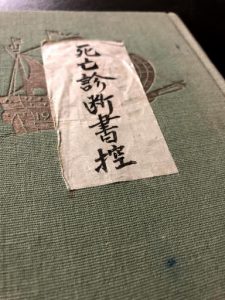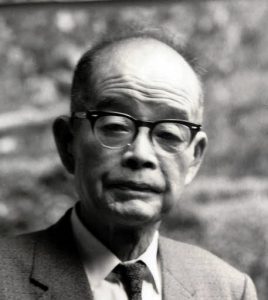Striving to fill voids in Hiroshima, evidence of victims remains 76 years after atomic bombing ― “Burns,” “poisoning” used to describe deaths from radiation, unknown weapon
Jul. 30, 2021
Asaminami Ward clinic archives death certificate copies for 61 A-bomb victims
by Junji Akechi, Staff Writer
Ohnaka Clinic, located in Hiroshima’s Asaminami Ward, has in its possession copies of the death certificates of 61 atomic bomb victims who died between August 6, 1945—the date on which the U.S. military dropped the atomic bomb on Hiroshima—and January of the following year. Amid the uncertainty about the new type of bomb that devastated Hiroshima, cause of death of the numerous patients who died was described as “burns” or “poisoning.” An image of a physician responding to patients by trial and error through a situation of uncertainty is called to mind.
Written in a faded, cloth-covered journal were the words “Death certificate copies.” The main items, such as names of the dead, cause of death, date of first appearance of symptoms, and date of death, were written in fountain pen. Dr. Masami Ohnaka (1889–1976), director of the Ohnaka Clinic then, filled out the medical reports to serve as a record of the situation for submission to the local government offices.
Based on diagnosis information and other factors, 61 people were thought to have died because of the atomic bombing. Most were local residents, including people taken to a nearby national school. Of that total, 53 people were reported as having developed symptoms on August 6, with 56 people dying by the end of September. Ages of the victims, as far as can be ascertained, range from infancy to 72 years, proof that the atomic bombing took citizen lives indiscriminately. Akimi Hashimoto, now 91, a resident of Hiroshima’s Asaminami Ward who had lived and worked at the clinic at that time, recalled, “The doctor treated patients day and night.”
Until mid-August, cause of death was almost always indicated as “burns.” Starting in late August, however, use of the term “poisoning” increased rapidly. The History of Hiroshima Atomic Bomb Medical Treatment (Hiroshima genbaku iryoushi, in Japanese, published by the Hiroshima Atomic Bomb Casualty Council in 1961) states that early research into radiation effects showed that moderate exposure caused many deaths, with severe symptoms such as diarrhea, hair loss, and bleeding arising two to six weeks after exposure. No detailed symptom descriptions are listed in the medical certificate copies, but it is apparent that the physician diagnosed the rapidly increasing cases of acute radiation health effects as “poisoning.”
Use of the term “A-bomb related diseases” clearly appeared starting in early September 1945. This was after Professor Masao Tsuzuki of Tokyo Imperial University gave a lecture on the effects of radiation in Hiroshima on September 3 that was picked up by the media. In the medical certificate copies, even in the margins of earlier medical certificates, parenthetical notes used the term “A-bomb related diseases.” Because the color and density of the ink used in the notes differed, the term appears to have been added later.
Dr. Ohnaka opened his clinic at the present location in 1920. At that time, he was one of two physicians operating clinics in the area. A list of the wounded based on notes that the other physician Yoshimichi Shirai (1897–1964) wrote when he was administering first-aid to the sick and wounded was found in 1973.
Toshifumi Ohnaka, 63, current director of the clinic and grandson of Masami Ohnaka, took the opportunity presented by our interview to once again open and take a look at the medical certificate copies. He said, “My grandfather didn’t talk to me about this issue, but when I see these copies, I can actually sense he was making medical diagnoses right after the atomic bombing.” Toshifumi inherited not only the clinic but also the records. Therein are inscribed the struggles of his grandfather, a physician confronted with the inhumanity of the atomic bombing.
(Originally published on July 30, 2021)









